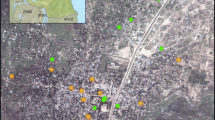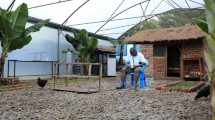Abstract
The impact of a new design of permethrin-impregnated wall cloth (“Mbu” (mosquito) cloth) on mosquito populations was assessed in Marigat area of Baringo District, Kenya. The cloth was fitted in 2000 houses. Mosquito relative density, species composition and the proportion of blood-fed females before and during the use of the Mbu cloth were monitored by hand catch, exit trap and CDC light trap catches. The common mosquito species were Culex quinquefasciatus, Mansonia uniformis, Anopheles gambiae sensu lato and An. funestus. A statistically significant decline in the mosquito population was observed following the introduction of the cloth. The decline was particularly high during the first and second six month impregnation cycles when it ranged between 43 and 94% indoors. C. quinquefasciatus was less affected by the cloth than other species, while M. uniformis apparently avoided treated houses. An. gambiae s.l. and An. funestus were collected in extremely low numbers during the post-treatment period. The Mbu cloth and other permethrin impregnated wall-hanging fabrics constitute a novel way of controlling mosquitoes and malaria in rural communities.
Résumé
L’effet d’un nouveau modèle d’écran traité à la permethrine (“Mbu” (moustique) cloth) sur les populations des moustiques a été évalué dans la localité de Marigat, District de Baringo au Kenya. Les écrans ont été fixés dans 2000 maisons. La densité relative des moustiques, la composition spécifique et la proportion des femelles nourries au sang avant et pendant l’emploi d’écran étaient régulièrement surveillées en utilisant la technique de capture à la main, le piège fenêtre, et le piège lumineux (CDC). Les espèces de moustiques les plus rencontrées étaient Culex quinquefasciatus, Mansonia uniformis, Anopheles gambiae s.l. et An. funestus. Une réduction statistiquement significative des populations de moustiques était observée après l’introduction d’écran. Elle était particulièrement élevée pendant le premier et le second cycles de traitement. Cette réduction se rangeait entre 43 et 94% (à l’intérieur des maisons). C. quinquefasciatus était moins affecté par l’écran, alors que M. uniformis apparemment évitait les maisons traitées. An. gambiae s.l. et An. funestus ont été extremment peu attrapés pendant la période d’après traitement. L’écran (Mbu cloth) et autres matériaux impregnés à la permethrine constituent un nouveau moyen pour controller les moustiques et le paludisme dans les communautés rurales.
Similar content being viewed by others
References
Aniedu L, Mutinga M. J. and Mutero C. M. (1989) Age composition and survival rate of Anopheles gambiae Giles complex. (Diptera: culicidae) in Baringo District, Kenya. J. Appl. Entomol. 107, 387–394.
Curtis C. F. and Lines J. D. (1985) Impregnated fabrics against malaria mosquitoes. Parasitology Today 1, 147.
Curtis C. F., Lines J. D., Carnevale P., Robert V., Boudin C, Halna J. M., Pazart L., Gazin P., Richard A., Mouchet J., Charlwood J. D., Graves P. M., Hossain M. I., Kurihara T., Ichimori K., Zuzi L., Baolin L., Majori G., Sabatinelli G., Coluzzi M., Njunwa K. J., Wilkes T. J., Snow R. J. and Lindsay S. W. (1990) Impregnated bednets and curtains against malaria mosquitoes. In Appropriate Technology in Vector Control (Edited by Curtis C. F.), pp. 233. CRC Press Boca Raton, Florida.
Hossain M. I. and Curtis C. F. (1989) Assays of permethrin-impregnated fabrics and bioassays with mosquitoes (Diptera: culicidae). Bull. entomol. Res. 79, 299–308.
Lines J. D., Myamba J. and Curtis C. F. (1987) Experimental hut trials of permethrin-impregnated nets and curtains against malaria vectors in Tanzania. Med. Vet. Entomol. 1, 37–51.
Lines J. D., Curtis C. F., Wilkes T. J. and Njunwa K. J. (1991) Monitoring human-biting mosquitoes (Diptera: culicidae) in Tanzania with light-traps hung beside mosquito nets. Bull, entomol. Res. 81, 77–84.
MacCormack C. P. and Snow R. W. (1986) Gambian cultural preferences in the use of insecticide treated bed nets. J. Trop. Med. Hyg. 89, 295–302.
Magesa S. M., Wilkes T. J., Mnzava A. E. P., Njunwa K. J., Nyamba J., Phillip M. D., Hill N., Lines J. D. and Curtis C. F. (1991) Trial of pyrethroid treated bednets in an area of Tanzania holoendemic for malaria. Part 2: Effects on the malaria vector population. Acta Tropica. 49, 97–108.
Mutero C. M. and Birley M. H. (1987) Estimation of the survival rate and oviposition cycle of field populations of malaria vectors in Kenya. J. Appl. Ecol. 24, 853–863.
Njunwa K. J., Lines J. D., Magesa S. M., Mnzava A. E. P., Wilkes T. J., Alilio M., Kivumbi K. and Curtis C. F. (1991) Trial of pyrethroid impregnated bednets in an area of Tanzania holoendemic for malaria. Part 1. Operational methods and acceptability. Acta Tropica 49, 87–96.
Quelennec G. (1988) Pyrethroids in the WHO pesticide evaluation scheme (WHOPES). Parasitology Today 4, 15–17.
Rozendaal J. A. and Curtis C. F. (1989) Recent research on impregnated mosquito nets. J. Am. Mosq. Contr. Assoc. 5, 500–507.
SAS (1987) SAS/STAT Guide for Personal Computers. Version 6 edn. SAS Institute Inc., Cary, North Carolina.
Service M. W. (1976) Mosquito Ecology. Field Sampling Methods. Applied Science Publishers Ltd., London.
Snow R. W., Rowan K. M. and Greenwood B. M. (1987) A trial of permethrin-treated bednets in the prevention of malaria in Gambian children. Trans. R. Soc. trop. Med. Hyg. 81, 563–567.
White G. B. (1974) Anopheles gambiae complex and disease transmission in Africa. Trans. R. Soc. trop. Med. Hyg. 68, 278–301.
WHO (1975) Manual onPractical Entomology in Malaria. Part II. Methods and Techniques. (WHO offset publication No. 13). World Health Organization, Geneva.
WHO (1987) Tropical Disease Research: A global partnership. Eighth Programme Report of the UNDP/WorldBank/WHO Special Programme for Research and Training in Tropical Diseases (TDR). World Health Organization, Geneva.
Zuzi L., Mancheng Z., Yuguang W., Binglin Z., Guangyu L. and Hui H. (1989) Trial of deltamethrin impregnated bednets for the control of malaria transmitted by Anopheles sinensis and Anopheles anthropophagus. Am. J. Trop. Med. Hyg. 40, 356–359.
Author information
Authors and Affiliations
Rights and permissions
About this article
Cite this article
Mutinga, M.J., Mutero, C.M., Basimike, M. et al. The Use of Permethrin-Impregnated Wall Cloth (Mbu Cloth) for Control of Vectors of Malaria and Leishmaniases in Kenya — I. Effect on Mosquito Populations. Int J Trop Insect Sci 13, 151–161 (1992). https://doi.org/10.1017/S1742758400014296
Received:
Published:
Issue Date:
DOI: https://doi.org/10.1017/S1742758400014296
Key Words
- Permethrin-impregnated (Mbu) cloth
- mosquitoes
- Anopheles gambiae s.l.
- malaria
- Culex quinquefasciatus
- Baringo
- Kenya




